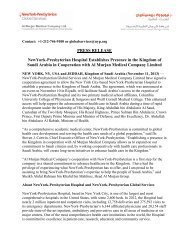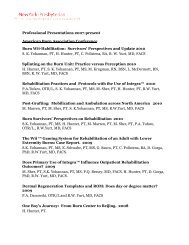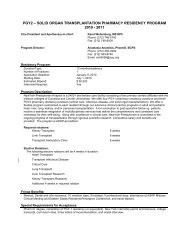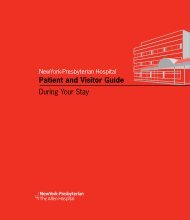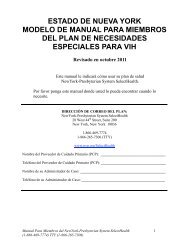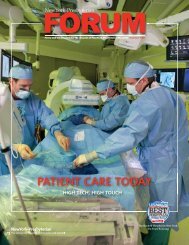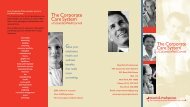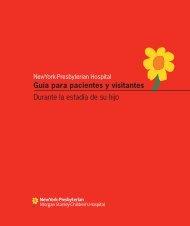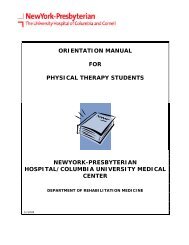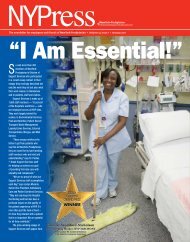Patient and Visitor Guide - New York Presbyterian Hospital
Patient and Visitor Guide - New York Presbyterian Hospital
Patient and Visitor Guide - New York Presbyterian Hospital
You also want an ePaper? Increase the reach of your titles
YUMPU automatically turns print PDFs into web optimized ePapers that Google loves.
For Your Safety <strong>and</strong> Security _ 23<br />
Follow <strong>Visitor</strong> <strong>Guide</strong>lines<br />
We want you to help prevent the spread of infection too. If your family members or friends have a<br />
cold, cough, fever, or rash, please ask them not to visit until they are better. Ask your visitors to<br />
clean their h<strong>and</strong>s with Purell ® before they come into your room.<br />
Know About Health Care-Associated Infections <strong>and</strong> Precautions<br />
All hospitals strive to prevent health care-associated infections. These infections include:<br />
• Surgical site infections, which can happen after surgery at the area on the body where surgery<br />
was performed.<br />
• Central line-associated blood stream infections, which can occur in patients who have a central line<br />
catheter in their vein. These catheters are placed so that the patient can receive medications <strong>and</strong><br />
blood transfusions.<br />
• Multi-drug resistant organism infection, which is a type of infection that may not be related to a<br />
procedure. This type of infection, which can affect any part of the body, is caused by bacteria that<br />
are resistant to many antibiotics. Resistance means that the bacteria have become harder to treat.<br />
These infections can be passed from patient to patient if proper prevention practices are not<br />
followed. They can also occur as a result of treatment with antibiotics.<br />
When you have a procedure, such as an operation, a cardiac catheterization, or a central line placement,<br />
strict guidelines are in place to help prevent infections. Sterile drapes are used to create<br />
barriers to prevent contamination of the body site being worked on. In addition to performing h<strong>and</strong><br />
hygiene, the health care team:<br />
• wears sterile gowns, gloves, caps, <strong>and</strong> masks<br />
• uses sterile supplies <strong>and</strong> surgical instruments<br />
• cleans the skin with an antiseptic where the procedure is to be done<br />
Before some operations, patients are given antibiotics to prevent infections.<br />
In some cases, to help prevent health care-associated infections, we place patients on isolation<br />
precautions in a single room. <strong>Patient</strong>s who have been diagnosed with a multi-drug resistant organism<br />
infection may also be placed on contact isolation. If you are on contact isolation, health care team<br />
members may wear a mask, gown, or gloves when coming to see you — although you may still<br />
remain in a two-bedded room. Please check with your nurse about precautions you should take.<br />
If you have questions about preventing health care-associated infections, please ask your doctor<br />
or nurse.



